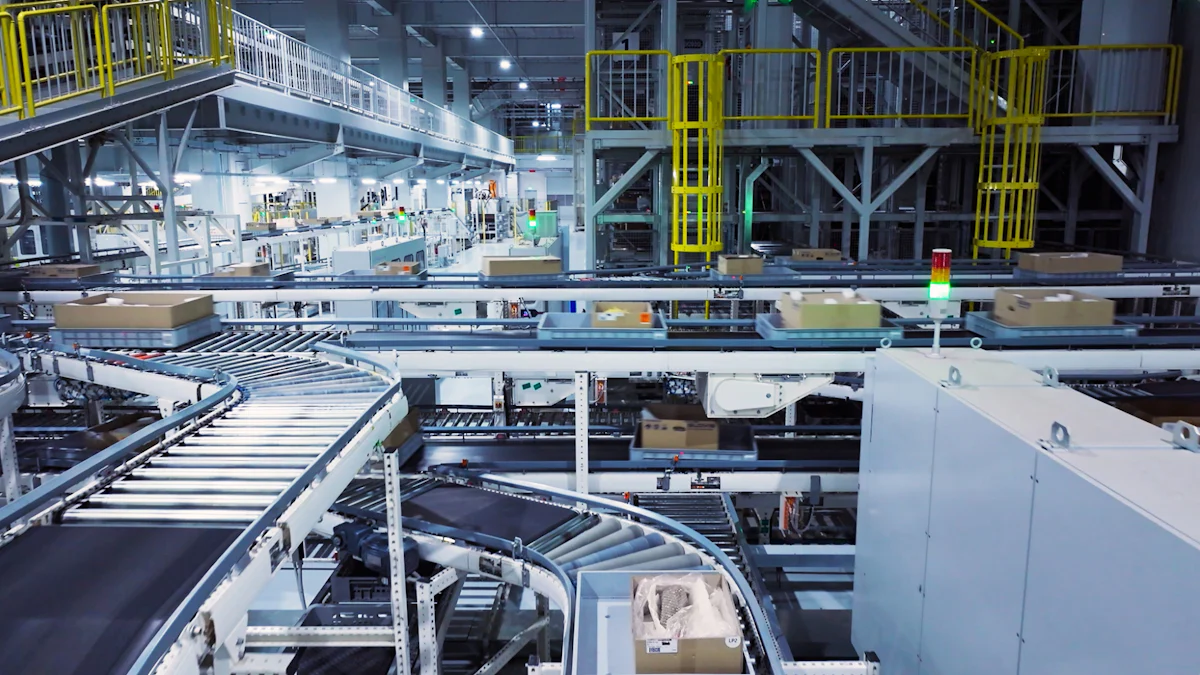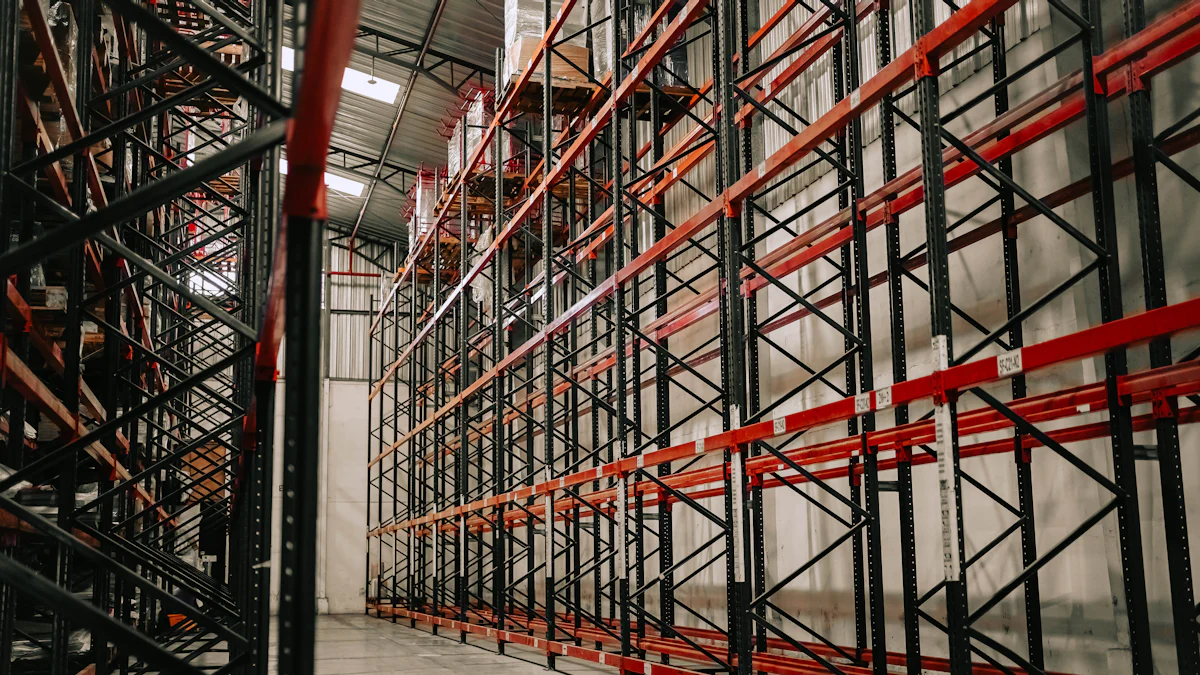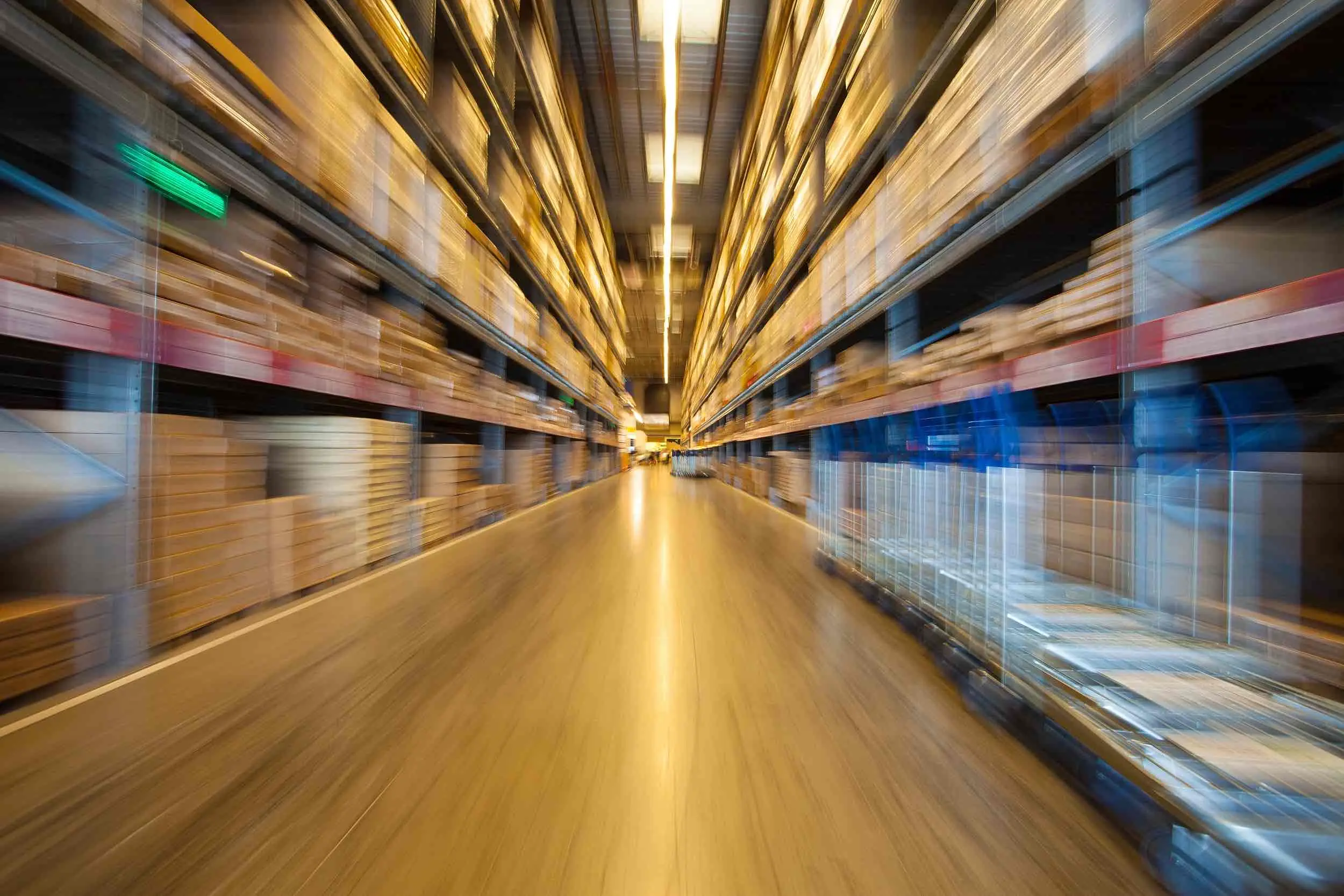Emerging Trends in Modern Warehouse Design and Technology in 2025

Modern warehouses are undergoing a transformative shift as businesses strive to stay competitive in an evolving landscape. Nearly one-quarter of warehouses today utilize automation, and this number is expected to grow significantly by 2025. The integration of advanced technology, such as AI-driven systems and robotics, is reshaping the future of warehousing. These innovations not only enhance operational efficiency but also address challenges like labor shortages and accuracy demands. As warehousing trends lean toward intelligence and sustainability, the rise of the smart warehouse marks a pivotal moment in modern warehousing.
Automation and Robotics in Modern Warehouses

The integration of automation and robotics has become a cornerstone of warehouse automation. These technologies are transforming traditional operations, enabling businesses to achieve higher efficiency, accuracy, and safety. By leveraging advanced systems, warehouses are evolving into smarter, more agile environments that meet the demands of modern logistics.
AI-Powered Robotics for Warehouse Automation
Autonomous mobile robots (AMRs) for inventory management
Autonomous mobile robots (AMRs) are revolutionizing inventory management in warehouses. These robots navigate warehouse floors independently, using sensors and AI algorithms to avoid obstacles and optimize routes. AMRs streamline inventory tracking by transporting goods between storage areas and workstations with precision. This reduces human intervention and minimizes errors. Their ability to operate continuously enhances productivity, making them an essential component of automated warehouse systems.
Scientific Research Findings: Studies highlight that AI-powered systems, including AMRs, improve operational efficiency by reducing downtime and increasing productivity. These robots also provide real-time data for better inventory management decisions.
AI-driven picking and packing systems
AI-driven picking and packing systems are redefining warehouse automation trends. These systems use machine learning algorithms to identify, pick, and pack items with remarkable speed and accuracy. By analyzing historical data, AI optimizes the placement of goods, ensuring faster retrieval times. This innovation not only accelerates order fulfillment but also reduces labor costs. Warehouses adopting these systems experience significant improvements in operational efficiency and customer satisfaction.
Key Insight: AI-driven warehouse operations enhance responsiveness to market demands by predicting inventory needs and automating error management.
Collaborative Robots (Cobots) in the Future of Warehousing
Enhancing human-robot collaboration for efficiency
Collaborative robots, or cobots, are designed to work alongside human employees, enhancing efficiency in warehouse operations. Unlike traditional robots, cobots focus on complementing human tasks rather than replacing them. They assist with repetitive and physically demanding activities, such as lifting heavy items or sorting packages. This collaboration allows workers to focus on more complex tasks, boosting overall productivity.
Industry Trend: Cobots are becoming a key element in automation through AI and robotics, as they bridge the gap between human capabilities and robotic precision.
Reducing workplace injuries and improving safety
Cobots play a vital role in improving workplace safety. By taking over hazardous tasks, they reduce the risk of injuries caused by repetitive strain or heavy lifting. Their built-in sensors and AI capabilities ensure safe interactions with human workers. This creates a safer and more ergonomic working environment, which is crucial for maintaining employee well-being in warehouses.
Fact: Automation through AI and robotics not only enhances efficiency but also addresses safety concerns, making warehouses more secure for employees.
Automated Guided Vehicles (AGVs) in Warehouse Automation Trends
Streamlining material handling and transportation
Automated Guided Vehicles (AGVs) are transforming material handling and transportation within warehouses. These vehicles follow pre-defined paths to transport goods efficiently across the facility. AGVs reduce the reliance on manual labor, ensuring consistent and error-free operations. Their ability to handle large volumes of goods makes them indispensable in high-demand environments.
Research Insight: Robotic solutions, such as AGVs, play a critical role in warehouse automation by providing real-time information for inventory management and delivery optimization.
Integration with advanced warehouse management systems (WMS)
AGVs integrate seamlessly with advanced warehouse management systems (WMS), creating a cohesive and efficient operational framework. This integration enables real-time tracking of goods, optimizing storage and retrieval processes. By combining AGVs with WMS, warehouses achieve greater visibility and control over their operations, leading to improved decision-making and reduced operational costs.
Emerging Trend: The integration of AGVs with WMS represents a significant step forward in warehouse automation trends, offering unparalleled efficiency and scalability.
Sustainability and Green Practices in Warehouse Design

The warehousing industry is embracing sustainability as a core principle, reshaping operations to align with environmental goals. By prioritizing sustainable practices, warehouses are not only reducing their ecological footprint but also achieving cost savings and operational efficiency. These green initiatives are setting new trends in modern warehouse design, ensuring that facilities remain competitive and environmentally responsible.
Energy-Efficient Solutions for Modern Warehouses
Solar panels and renewable energy systems
Warehouses are increasingly adopting solar panels and renewable energy systems to reduce reliance on traditional power sources. Solar panels harness sunlight to generate clean energy, significantly lowering electricity costs and carbon emissions. Many facilities are integrating these systems into their designs, creating self-sustaining energy solutions. Renewable energy adoption reflects the industry's commitment to sustainability and green logistics, paving the way for a more eco-friendly future.
Example: Some warehouses have achieved energy independence by combining solar panels with energy storage systems, ensuring uninterrupted operations even during power outages.
LED lighting and smart energy management
LED lighting has become a staple in energy-efficient warehouse designs. These lights consume less energy than traditional bulbs while providing superior illumination. Smart energy management systems further enhance efficiency by monitoring and optimizing energy usage across the facility. These systems adjust lighting and temperature based on real-time data, minimizing waste and maximizing savings.
Fact: Studies show that LED lighting can reduce energy consumption by up to 75%, making it a cost-effective and sustainable choice for warehouses.
Eco-Friendly Materials and Construction in Warehousing
Use of recycled and sustainable building materials
Modern warehouses are incorporating recycled and sustainable materials into their construction. These materials, such as reclaimed wood and recycled steel, reduce the environmental impact of building processes. By using eco-friendly resources, warehouses contribute to the circular economy while maintaining structural integrity and durability.
Insight: Facilities built with sustainable materials often achieve higher energy efficiency, further supporting their green initiatives.
Green certifications and compliance
Green certifications, such as LEED (Leadership in Energy and Environmental Design), are becoming a benchmark for sustainable warehouse construction. These certifications recognize facilities that meet stringent environmental standards, including energy efficiency, water conservation, and waste reduction. Achieving compliance not only enhances a warehouse's reputation but also attracts environmentally conscious clients.
Trend: Warehouses with green certifications are gaining a competitive edge in the logistics industry, reflecting the growing importance of sustainability.
Waste Reduction and Circular Economy in the Future of Warehousing
Recycling programs for packaging materials
Recycling programs are integral to waste reduction efforts in warehouses. Facilities are implementing systems to recycle packaging materials, such as cardboard, plastic, and pallets. These programs minimize waste sent to landfills and promote the reuse of resources, aligning with the principles of the circular economy.
Example: Some warehouses collaborate with suppliers to create take-back programs, ensuring that packaging materials are returned and recycled efficiently.
Minimizing carbon footprint through optimized logistics
Optimized logistics play a crucial role in reducing a warehouse's carbon footprint. By streamlining transportation routes and utilizing energy-efficient technologies, facilities can lower fuel consumption and emissions. Advanced software solutions enable real-time tracking and route optimization, ensuring that goods are delivered with minimal environmental impact.
Key Insight: Warehouses that adopt optimized logistics strategies not only reduce their carbon footprint but also improve delivery times and customer satisfaction.
Space Optimization and Urban Warehousing with JUSDA
The rapid growth of e-commerce has driven significant changes in warehouse design, with businesses prioritizing space optimization and proximity to urban areas. JUSDA's innovative solutions address these demands by offering advanced storage systems, urban warehousing strategies, and flexible layouts that adapt to evolving market needs.

JUSDA Solutions
To provide you with professional solutions and quotations.
Vertical Storage Solutions for Modern Warehouses
High-density shelving and automated vertical lifts
Modern warehouses are utilizing high-density shelving systems and automated vertical lifts to maximize storage efficiency. These solutions allow facilities to store more inventory within the same footprint by leveraging vertical space. Automated vertical lifts streamline the retrieval process, reducing the time required to access goods. This approach not only increases storage capacity but also enhances operational efficiency.
Industry Insight: Warehouses today are reaching heights of up to 40 feet, enabling businesses to accommodate larger inventories while integrating automated storage and retrieval systems for improved productivity.
Maximizing storage capacity in limited spaces
Space constraints in urban areas demand innovative storage solutions. JUSDA's warehouses employ advanced designs that optimize every square foot. By combining vertical storage with intelligent inventory management systems, these facilities ensure seamless operations even in space-limited environments. This strategy supports the growing needs of e-commerce businesses, where efficient storage and quick access to goods are critical.
Key Advantage: Vertical storage solutions reduce the need for additional real estate, making them a cost-effective choice for urban warehouses.
Urban Warehousing Trends and Proximity
Micro-fulfillment centers for faster delivery
The rise of e-commerce has increased the demand for micro-fulfillment centers. These small-scale warehouses are strategically located near urban areas to enable faster order processing and delivery. JUSDA's micro-fulfillment centers are equipped with advanced automation technologies, ensuring rapid and accurate order fulfillment. This approach caters to the expectations of modern consumers who prioritize speed and convenience.
Example: Micro-fulfillment centers reduce delivery times by processing orders closer to the end customer, meeting the growing demand for same-day or next-day delivery services.
Proximity to urban areas to reduce last-mile delivery times
Urban warehouses play a crucial role in minimizing last-mile delivery times. By positioning facilities closer to city centers, JUSDA helps businesses reduce transportation costs and improve delivery efficiency. This strategy aligns with current trends in logistics, where proximity to consumers is essential for maintaining a competitive edge in the e-commerce sector.
Fact: Warehouses located near urban centers not only cut delivery times but also lower fuel consumption, contributing to sustainability goals.
Flexible and Modular Layouts in JUSDA Warehouses
Adapting to changing inventory needs
JUSDA's warehouses feature flexible layouts designed to adapt to fluctuating inventory demands. Modular storage systems allow facilities to reconfigure spaces quickly, accommodating seasonal variations or shifts in product categories. This adaptability ensures that warehouses remain efficient and responsive to market changes.
Emerging Practice: Flexible layouts enable businesses to scale operations without significant disruptions, making them ideal for the dynamic nature of e-commerce.
Scalable designs for future growth
Scalability is a cornerstone of JUSDA's warehouse solutions. Facilities are built with future growth in mind, incorporating modular designs that can expand as business needs evolve. This forward-thinking approach ensures that warehouses can support long-term operational goals while maintaining efficiency.
Trend: Scalable warehouse designs provide businesses with the flexibility to grow alongside the expanding e-commerce market, ensuring sustained success.
Technology Integration in Warehouse Automation Trends
The integration of advanced technologies is revolutionizing warehouse automation, enabling businesses to achieve unprecedented levels of efficiency and accuracy. By leveraging tools like the Internet of Things (IoT), blockchain, and cloud-based systems, warehouses are transforming into intelligent ecosystems that support real-time inventory tracking, supply chain optimization, and seamless operations.
Internet of Things (IoT) in Modern Warehouses
Real-time tracking of inventory and assets
IoT devices have become a cornerstone of modern warehouse automation. These devices, equipped with sensors and RFID tags, enable real-time tracking of inventory and assets. Warehouses can monitor the movement of goods across facilities with pinpoint accuracy, reducing errors and improving operational efficiency. IoT-powered systems provide instant updates on stock levels, ensuring that businesses can respond quickly to demand fluctuations.
Expert Testimony:
"IoT devices and RFID tags enhance real-time data processing, security, and confidentiality in warehouse operations," state experts in warehouse management systems. This capability ensures accurate inventory tracking and minimizes human error.
IoT integration also supports predictive analytics, allowing warehouses to anticipate inventory shortages or surpluses. This proactive approach reduces downtime and optimizes storage space, making it an essential component of supply chain optimization.
Predictive maintenance for equipment
IoT sensors play a critical role in maintaining warehouse equipment. These sensors monitor machinery performance and detect potential issues before they escalate into costly breakdowns. Predictive maintenance ensures that equipment operates at peak efficiency, reducing downtime and extending the lifespan of assets.
Key Insight: IoT-enabled predictive maintenance not only lowers repair costs but also enhances overall productivity by minimizing disruptions in warehouse operations.
Blockchain for Supply Chain Transparency in Warehousing
Enhancing traceability and security in transactions
Blockchain technology is redefining transparency and security in warehouse operations. By creating an immutable ledger, blockchain ensures that every transaction and movement of goods is recorded accurately. This level of traceability is particularly valuable in industries requiring stringent compliance, such as pharmaceuticals and high-value collectibles.
Expert Testimony:
"Blockchain provides a secure and accountable way to track goods with an immutable ledger for transaction records," according to specialists in supply chain integration. This innovation enhances trust among stakeholders and reduces the risk of fraud.
Blockchain also facilitates seamless collaboration between suppliers, warehouses, and customers. The technology ensures that all parties have access to consistent and reliable data, streamlining supply chain processes.
Reducing fraud and errors in logistics
Fraud and logistical errors pose significant challenges in warehouse management. Blockchain addresses these issues by providing a transparent and tamper-proof record of all activities. This reduces discrepancies in inventory tracking and ensures that goods reach their intended destinations without delays.
Fact: Warehouses utilizing blockchain technology report fewer instances of fraud and improved accuracy in logistics, highlighting its transformative impact on supply chain optimization.
Cloud-Based Warehouse Management Systems by JUSDA
Centralized data access and analytics
Cloud-based warehouse management systems (WMS) offer centralized access to critical data, enabling real-time insights into warehouse operations. JUSDA's advanced WMS integrates seamlessly with IoT devices and other automation tools, providing a unified platform for inventory tracking, order processing, and performance analysis.
Example: JUSDA's cloud-based WMS allows businesses to monitor inventory levels across multiple locations, ensuring efficient resource allocation and timely order fulfillment.
The system's analytics capabilities empower decision-makers with actionable insights, helping them identify trends and optimize processes. This data-driven approach enhances operational efficiency and supports long-term growth.
Seamless integration with other business systems
JUSDA's WMS stands out for its ability to integrate with other business systems, such as enterprise resource planning (ERP) and transportation management systems (TMS). This integration creates a cohesive ecosystem that streamlines workflows and eliminates redundancies.
Emerging Practice: Businesses leveraging JUSDA's WMS benefit from improved supply chain integration, enabling them to adapt quickly to changing market demands.
By combining cloud technology with advanced automation tools, JUSDA ensures that warehouses remain agile and competitive in an increasingly dynamic industry.
Future-Proofing Warehouses with JUSDA Solutions
As the logistics landscape evolves, future-proofing warehouses has become a critical focus for businesses. JUSDA offers innovative solutions that ensure adaptability, scalability, and operational excellence in the face of emerging trends and technological advancements.
Scalability and Adaptability in the Future of Warehousing
Designing warehouses to accommodate future technologies
Warehouses must evolve to integrate cutting-edge technologies seamlessly. JUSDA emphasizes designing facilities that can accommodate advancements such as AI-driven systems, robotics, and warehouse automation. These designs prioritize modularity, enabling businesses to incorporate new tools without disrupting existing operations. By preparing for future innovations, warehouses remain competitive and efficient.
Industry Insight:
"Warehouses designed with flexibility in mind are better equipped to adopt emerging technologies like AI and IoT," state industry leaders in warehouse automation.
JUSDA’s approach ensures that warehouses are not only equipped for current demands but also ready to embrace future breakthroughs in automation and sustainability.
Flexible layouts for evolving business needs
Dynamic market conditions require warehouses to adapt quickly. JUSDA’s flexible layouts allow businesses to reconfigure spaces based on inventory changes or seasonal demands. This adaptability supports efficient operations, even during periods of rapid growth or shifting consumer preferences. Modular storage systems and intelligent warehouse management systems further enhance this flexibility.
Key Advantage: Flexible layouts reduce downtime during transitions, ensuring uninterrupted operations while meeting evolving business needs.
Workforce Training and Upskilling for Warehouse Automation
Preparing employees for tech-driven operations
The rise of automation and AI in warehouses demands a skilled workforce. JUSDA prioritizes workforce training to prepare employees for tech-driven environments. Training programs focus on operating advanced systems, managing automated processes, and leveraging AI tools effectively. This ensures that employees remain integral to warehouse operations, even as automation increases.
Expert Testimony:
"Investing in workforce training bridges the gap between human expertise and automation, creating a harmonious working environment," according to automation specialists.
By equipping employees with the necessary skills, JUSDA fosters a collaborative ecosystem where humans and technology work together seamlessly.
Emphasizing continuous learning and development
Continuous learning is essential in an industry driven by rapid technological advancements. JUSDA encourages ongoing development programs to keep employees updated on the latest trends in warehouse automation and AI. These initiatives enhance employee confidence and productivity, ensuring that the workforce remains agile and capable of adapting to future challenges.
Fact: Warehouses with well-trained staff experience fewer operational disruptions and higher efficiency, highlighting the importance of upskilling in modern logistics.
Investment in Research and Development for Modern Warehouses
Staying ahead of industry trends through innovation
JUSDA invests heavily in research and development to stay ahead of industry trends. By exploring new technologies and refining existing systems, the company ensures that its warehouses remain at the forefront of innovation. This commitment to R&D enables JUSDA to offer solutions that address both current challenges and future opportunities.
Example: JUSDA’s integration of AI-powered tools into warehouse automation has significantly improved inventory management and operational accuracy.
Through continuous innovation, JUSDA helps businesses navigate the complexities of modern logistics with confidence.
Partnering with tech providers for custom solutions
Collaboration with technology providers plays a vital role in JUSDA’s strategy. These partnerships enable the development of tailored solutions that meet specific business needs. From AI-driven analytics to advanced warehouse management systems, JUSDA ensures that its clients benefit from cutting-edge tools designed for their unique requirements.
Emerging Practice: Custom solutions enhance operational efficiency by addressing individual challenges, making them a cornerstone of future-ready warehouses.
By combining expertise in automation with strategic partnerships, JUSDA delivers solutions that empower businesses to thrive in an ever-changing industry.
The trends shaping modern warehouse design and technology in 2025 are revolutionizing the logistics industry. Businesses that adopt automation, sustainability, and advanced technologies position themselves for long-term success. Automation enhances operational efficiency, while sustainability initiatives reduce environmental impact and operational costs. Space optimization strategies, such as vertical storage and urban warehousing, address the growing demands of e-commerce. JUSDA’s innovative solutions empower businesses to adapt to these changes seamlessly. By embracing these advancements, companies can future-proof their operations and maintain a competitive edge in an evolving market.
See Also
Exploring Automation's Role in Modern Manufacturing Warehouses
Key Trends Shaping Supply Chain Efficiency in the Future
Understanding How Robotics Enhance Efficiency in Warehousing
Boosting Warehouse Productivity Through Advanced Logistics Robotics
